Hi Seth!
I'm curious, Where are you going to observe these awesome little creatures I've been doing some hiking here in Whatcom county, Wa. I would like to get some photos of these guys in their natural habitat.
I ask, because I joined a local Herp group here in Whatcom county, Wa last fall. Who go hiking in certain ares and count the newts, salamanders frogs and toads, plus counting and identifying the eggs we see. We started the hunt two weeks ago. It's been really fun, but sad at the same time, I realize it's still early, but it has also been warm too. From what I've been told, Over the years, because of farming and building, the populations have been dwindling. In Ferndale, Tennant Lake is about dead because of farming pollution. The fish are almost gone, even the red winged black birds have left, along with the yellow finches. I'm one of those 35 year old, Old farts that likes bird watching. ;-). Actually, I'm a nature watcher. If it'll sit still long enough, I'm gonna photograph it

. Anyways, Ever since I got Baby Sinclair (Taricha granulosa) last year, I've been wanting to learn more about her and her natural habitat. I've been taking the kids out on rainy days with the group to do the counts, but about all we've accomplished is an accumulation of muddy laundry with only a couple sightings. I'd like the kids to see something before they get bored with the idea and give up on it all together. I'm hoping this will be a way to get them to care about the environment and the impacts of pollution. Because honestly, I used to love Tennant Lake as a child, and it's just not the same any more. It's quiet, has been for a couple years now, but I dint know why. It literally makes me want to cry, and it's not that I want the kids to be sad and cry, but I want them to care about it as much as the rest of us

. Know what I mean?
The kids love Sinclair, but I need them to realize she is a wild animal, not just a family member (if it lives in my house, it's family - except the spiders.

). They need to understand that what we do as people, affects everything. I'm even on the hunt to buy newt eggs in the hope of them starting an appreciation for All things living - even if it starts out as a transparent snot like glob.

.
Thank you for you time!
Tori
Hey Tori!
I am afraid giving exact locality info is against forum rules, but I can give you some tips on how to find these species

To find
T. granulosa ( rough skinned newt ) you should look for a likely breeding site first, like a pond, lake, or marsh. Google maps is a great way to find areas like this. Next, see if there is a road ( preferably small and little traveled ) that goes near it, or along it. Trails are also good. They will be forced to cross the road to get to the breeding site, so this is an opportune time to find them, and help them across. In my experiences they mainly cross after 12:00 PM, and may continue into the night. I have never had success on early morning road hunting, my guess is because the temperature is lower. Also, I have had best success
after rain, rather than during rain. They wont start crossing immediately after rain has stopped, though, it usually takes half hour or so. In the day time I always hunt on a bike, you can cover more ground a lot faster. Look at every object on the road that is big enough to be a newt, learn to recognize the profile of a crossing newt, head lifted off the ground ( more so in females than males ), belly on the ground behind front legs etc., you will get the hang of it. Sometimes you can spot them before they spot ( or feel? ) you, so they may still be moving which is easier to key in on. Also, don't look too far ahead of you, you want to be able to spot squished individuals, it will give you and idea of where most of them are crossing.
For
A. gracile ( northwestern salamander ) night hunting is essential to find live individuals. I have only ever once found this species crossing in the day ( one juvenile ). Any time after dark is fine, I usually don't search earlier that 7:00, though. I haven't ever done any really late herping for them, so I am not sure how likely you are to find them after 9:30 or so. They are more likely to be found crossing while it is raining, rather than after rain, though they can still be found during the latter weather. For night herping I would recommend going in a car, and one that has good bright headlights helps a lot. If not in a car than on foot is better than biking in my opinion, it is easier to hold several flashlights if you don't have to hold handlebars too! I actually went searching the roads on foot last night, I used one headlamp and two flashlights. It is quite peaceful, actually. Just me and the darkness, and one lone female
A. macrodactylum I found.
If you go looking for
T. granulosa in the day, keep an eye out for squished individuals of this species as well, for the same reasons previously stated.
Another way you can find
A. gracile is by going into forest adjacent to possible breeding sites and flipping logs, bark, and surface cover that they may be found under. Especially at this time of year when they are more likely to be active at the surface. When doing this you may also find other amphibian species, like
A. macrodactylum, P. vehiculum, and
E. e. oregonensis.
For
A. macrodactylum ( long toed salamander ), you can use the same search techniques as with
A. gracile.
Also, while road hunting, you might find some
P. regilla ( pacific chorus ( tree ) frog ), and
R. aurora ( red-legged frog ).
I completely understand you wanting to teach your kids about the importance of nature, and how all we do effects the animals that make life possible. I really want to see you succeed, and find amphibians, I really do. If you have any further questions, feel free to ask

Taricha always look so much better in the wild! And these beauties are no exception.

I haven't noticed any difference?
Beauties indeed!
-Seth

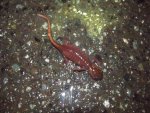
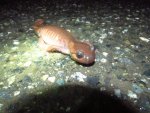

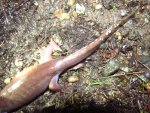
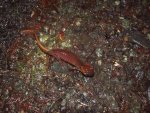
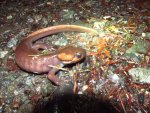
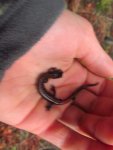





 European Newt Group
European Newt Group